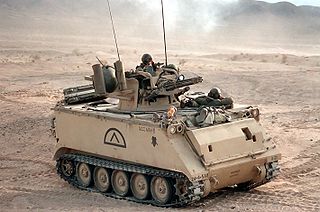 W
WThe M13 Multiple Gun Motor Carriage (MGMC), otherwise known as the M13 half-track, was a self-propelled anti-aircraft gun used by the U.S. Army during World War II that was armed with two .50 caliber M2HB heavy-barrel Browning machine guns. Developed in response to a requirement for a mobile anti-aircraft (AA) vehicle, the vehicle was produced by the White Motor Company between July 1942 and May 1943. The only time it was ever used in combat was when the Americans landed at Anzio in January 1944. It was replaced by the more heavily armed M16 Multiple Gun Motor Carriage in April 1944.
 W
WThe M15 half-track, officially designated M15 Combination Gun Motor Carriage, was a self-propelled anti-aircraft gun on a half-track chassis used by the United States Army during World War II. It was equipped with one M1 automatic 37 millimeter (1.5 in) gun and two water-cooled .50 caliber (12.7 mm) M2 Browning heavy machine guns. Based on the M3 half-track chassis, it was produced by the White Motor Company and Autocar between July 1942 and February 1944, and served alongside the M16 Multiple Gun Motor Carriage.
 W
WThe M16 Multiple Gun Motor Carriage, also known as the M16 half-track, was an American self-propelled anti-aircraft weapon built during World War II. It was equipped with four .50 caliber (12.7 mm) M2 Browning machine guns in an M45 Quadmount. 2700 were produced by White Motor Company from May 1943 to March 1944, with 568 M13 MGMCs and 109 T10 half-tracks being converted into M16s as well.
 W
WThe M19 Multiple Gun Motor Carriage (MGMC) was a World War II United States Army self-propelled anti-aircraft weapon on the M24 light tank chassis. It was equipped with two Bofors 40 mm guns. It was produced by Cadillac and Massey-Ferguson of Canada near the end of 1944.
 W
WThe M42 40 mm Self-Propelled Anti-Aircraft Gun, or "Duster," is an American armored light air-defense gun built for the United States Army from 1952 until December 1960, in service until 1988. Production of this vehicle was performed by the tank division of the General Motors Corporation. It used components from the M41 light tank and was constructed of all-welded steel.
 W
WThe M163 Vulcan Air Defense System (VADS) is a self-propelled anti-aircraft gun (SPAAG) that was used by the United States Army. The M168 gun is a variant of the General Dynamics 20 mm M61 Vulcan rotary cannon, the standard cannon in most U.S. combat aircraft since the 1960s, mounted on either an armored vehicle or a trailer.
 W
WThe M247 Sergeant York DIVAD was a self-propelled anti-aircraft gun (SPAAG), developed by Ford Aerospace in the late 1970s. Based on the M48 Patton tank, it replaced the Patton's turret with a new one that featured twin radar-directed Bofors 40 mm rapid-fire guns. The vehicle was named after Sergeant Alvin York, a famous World War I hero.
 W
WThe General Dynamics Mauler was a self-propelled anti-aircraft missile system designed to a late 1950s US Army requirement for a system to combat low-flying high-performance tactical fighters and short-range ballistic missiles.
 W
WThe MIM-72A/M48 Chaparral is an American self-propelled surface-to-air missile system based on the AIM-9 Sidewinder air-to-air missile system. The launcher is based on the M113 family of vehicles. It entered service with the United States Army in 1969 and was phased out between 1990 and 1998. It was intended to be used along with the M163 VADS, the Vulcan ADS covering short-range short-time engagements, and the Chaparral for longer range use.
 W
WThe Multi-Mission Launcher (MML) is an open-systems architecture multi-role missile launching system created by the United States Army's Aviation and Missile Research, Development, and Engineering Center.
 W
WUnited States Army air defense relies on a range of ground launched missiles ranging from hand held to vehicle mounted systems. The Air Defense Artillery is the branch that specializes in anti-aircraft weapons. In the US Army, these groups are composed of mainly air defense systems such as the PATRIOT Missile System, Terminal High Altitude Air Defense, and the Avenger Air Defense system which fires the FIM-92 Stinger missile.